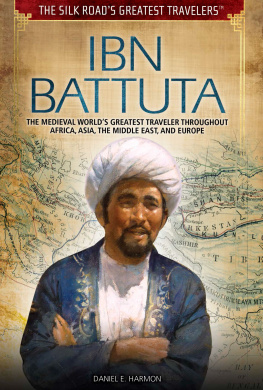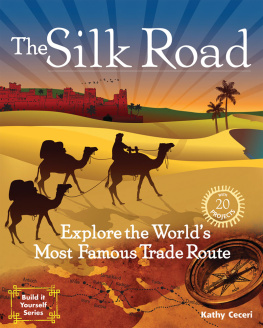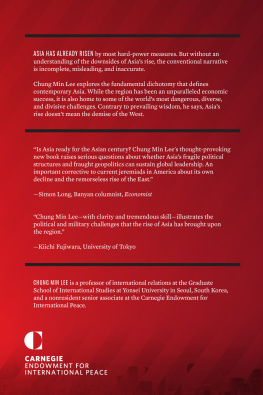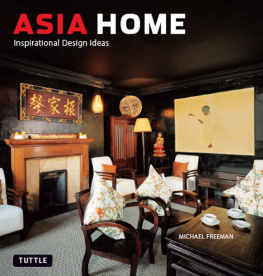Suggested Reading
CHAPTER 1:
MONASTERIES AND MONARCHS: XUANZANG
The standard English translation of the biography of Xuanzang is Samuel Beal, trans., The Life of Hiuen-Tsiang (London: Kegan Paul, Trench, Trbner and Co., 1911). There have been several reprints and retranslations since.
For Xuanzangs later life, see the extensive documents in Li Rongxi, A Biography of the Tripitika Master of the Great Cien Monastery of the Great Tang Dynasty, trans. Sramana Huli and Shi Yancong (Berkeley: Numata Center of Buddhist Translation and Research, 1995).
For a fuller treatment of Xuanzangs pilgrimage, see Sally H. Wriggins, The Silk Road Journey with Xuanzang (Boulder: Westview Press, 2004). Maps, illustrations, and bibliography are particularly useful.
Luce Boulnois, Silk Road: Monks, Warriors, and Merchants on the Silk Road (Odyssey Books: Hong Kong, 2004), is a series of short essays on various periods of Silk Road history from antiquity to the present. It also serves as a travel guide for those wanting to travel the Silk Road.
Richard C. Foltz, Religions of the Silk Road: Overland Trade and Cultural Exchange from Antiquity to the Fifteenth Century (New York: St. Martins Press, 1999), explores the complex interchanges and influences that Xuanzang observed and that continued for the subsequent millennium.
Tansen Sen, Buddhism, Diplomacy, and Trade: The Realignment of Sino-Indian Relations, 6001400 (Honolulu: University of Hawaii Press, 2003), is an excellent new study of the connections of pilgrimage, trade, and diplomacy in the centuries after Xuanzang.
CHAPTER 2:
CALIPH AND CARAVAN: IBN FADLAN
A recent translation of Ibn Fadlans memoir is Richard N. Frye, Ibn Fadlans Journey to Russia: A Tenth-Century Traveler from Baghdad to the Volga River (Princeton: Marcus Weiner Publishers, 2005). This volume has a useful introduction and notes.
The first few chapters of Michael Crichtons Eaters of the Dead (New York: Alfred A. Knopf, 1976) are based on the Ibn Fadlan memoir. The rest of the novel is more fanciful, based broadly on Beowulf.
For a sense of the luxurious cuisine in Baghdad in the time of the caliphs, there is a recent translation of a cookbook. See Charles Perry, A Baghdad Cookery Book (Devon, United Kingdom: Prospect Books, 2005).
Hugh Kennedy has produced excellent, readable studies of the caliphate. On the military side is The Armies of the Caliphs: Military and Society in the Early Islamic State (London: Routledge, 2001). Specifically on the court is When Baghdad Ruled the Muslim World: The Rise and Fall of Islams Greatest Dynasty (Boulder: Da Capo Press, 2005).
The larger context of trade across Central Asia at the time of Ibn Fadlan is discussed in Xinru Liu, Silk and Religion: An Exploration of Material Life and the Thought of People,6001200 (Delhi: Oxford University Press, 1996).
What is known about the Khazars is considered in Thomas Noonans essay, The Khazar Qaghanate, in Anatoly M. Khazanov and Andr Wink, eds., Nomads in a Sedentary World (Richmond, United Kingdom: Curzon, 2001).
CHAPTER 3:
PHILOSOPHER AND PHYSICIAN: IBN SINA
The standard English translation of Ibn Sinas autobiography is William E. Gohlman, The Life of Ibn Sina: A Critical Edition and Annotated Translation (Albany: State University of New York Press, 1974). The notes are particularly useful.
A portion of Ibn Sinas fascinating medical treatise is translated in Avicenna, The Canon of Medicine, adapted by Laleh Bakhtiar (Chicago: Great Books of the Islamic World, 1999).
On the influence of paper in the developing Muslim intellectual world, essential reading is Jonathan M. Bloom, Paper Before Print: The History and Impact of Paper on the Islamic World (New Haven: Yale University Press, 2001). The illustrations are stunning.
A well-written biography of Ibn Sina is Lenn E. Goodman, Avicenna (London: Routledge, 1992).
For those wanting to explore Ibn Sinas philosophy, a good introduction is Dimitri Guhas, Avicenna and the Aristotelian Tradition: An Introduction to Reading Avicennas Philosophical Works (Leiden, Holland: E. J. Brill, 1998).
Mahmud of Ghazna, from whom Ibn Sina fled, was both patron of the arts and conqueror. To this day, his life and deeds are controversial, as discussed in Clifford E. Bosworth, The Ghaznavids (Edinburgh: University Press, 1963).
Recent research on all phases of Ibn Sinas writing and influence is covered in Jules L. Janssens, An Annotated Bibliography on Ibn Sina (19701989) (Leuven, Belgium: Leuven University Press, 1991), and Jules L. Janssens, An Annotated Bibliography on Ibn Sina: First Supplement (19901994) (Louvain-la-Neuve, France: Fdration Internationale des Instituts dtudes Mdivales, 1999).
CHAPTER 4:
INGOTS AND ARTIFACTS: THE INTAN SHIPWRECK
The details of the undersea archaeology and the finds on the Intan wreck are thoroughly explored in Michael Flecker, The Archaeological Excavation of the Tenth-Century Intan Shipwreck, British Archaeological Reports International Series, 1047 (Oxford: Archaoepress, 2002).
A recent introduction to the larger context of the Intan wreck is Lynda N. Shaffer, Maritime Southeast Asia to 1500 (Armonk, New York: M. E. Sharpe, 1996).
The economic context of the wreck is found in Kenneth R. Halls essay in Nicholas Tarling, ed., The Cambridge History of Southeast Asia, vol. 1 (Cambridge: Cambridge University Press, 1992).
Fiona Kerlogue, Art of Southeast Asia (London: Thames and Hudson, 2004), illustrates several types of Buddhist monuments that had elaborate doorsperhaps of the type that the Intan ship was carrying.
A marvelous history and illustrated anthropology on the trade and use of beads in Borneo is Heidi Munan, Beads of Borneo (Kuala Lumpur: Editions Didier Millet, 2005). The color photographs are superb. Many of the strings of old beads have eye beads of the type found on the wreck.
CHAPTER 5:
PEPPER AND PARTNERSHIPS: ABRAHAM BIN YIJU
Abraham bin Yiju and especially his slave-business partner are the subject of a readable and entertaining history and ethnography by Amitav Ghosh, In an Antique Land (New York: Vintage Books, 1994).
For the patterns of the Indian Ocean trade, there is a masterful synthesis. See K. N. Chaudhuri, Trade and Civilization in the Indian Ocean: An Economic History from the Rise of Islam to 1750 (Cambridge: Cambridge University Press, 1985).
For information on Jewish communities and traders around the Mediterranean at the time of Abraham bin Yiju, see Shlomo Goitein, A Mediterranean Society: The Jewish Community of the Arab World as Portrayed in the Documents of the Cairo Geniza (Berkeley: University of California Press, 1967).
For more on Roger of Sicily, whose forces kidnapped Abrahams family, see John J. Norwich, The Normans in Sicily (London: Penguin Books, 1990).
A famous memoir of the twelfth-century Islamic world is that of Benjamin of Tudela, who traveled through Spain, North Africa, Egypt, and the Middle East. See The Itinerary of Benjamin of Tudela: Travels in the Middle Ages, introductions by Michael A. Signer, 1983, Marcus Nathan Adler, 1907, A. Asher, 1840 (Malibu, CA: C. Simon, 1983).
CHAPTER 6:
NOBLES AND NOTABLES: IBN BATTUTA
The Hakluyt Society has published the only complete English translation of Ibn Battutas long memoir. See H. A. R. Gibb, trans.,






